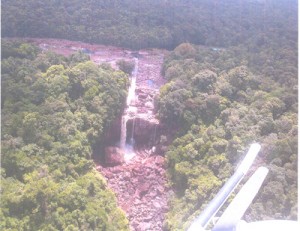
IDB still on board for Amaila hydropower project – President
PRESIDENT Donald Ramotar, yesterday disclosed that the Inter-American Development Bank (IDB) is “still on board” for the Amaila Falls Hydropower Project (AFHP).“We are working very hard to bring this back on stream,” he said at a news conference held at the Office of the President.
Mr. Ramotar stressed that the project is not dead, despite the challenges in the National Assembly relative to securing support for funding for the project.
“We are very close to taking a decision on what direction to go to put Amaila back on stream,” the President said.
The allocation of $1.3B for the provision of the Amaila access road and related structures was effectively given the green light from the Parliamentary Committee of Supply, in its review of the Ministry of Public Works’ 2014 budgetary allocation, in April this year.
When the vote was put the Members of Parliament (MPs), from the Government voted in support of the Ministry’s capital expenditures, which included the Amaila project, A Partnership for National Unity (APNU) voted no and the Alliance for Change (AFC) abstained. It was this abstention that allowed the project to go through.
On July 18, 2013, the combined Opposition in Parliament defeated the Hydroelectric Power (Amendment) Bill in the National Assembly, and in August the Government took the legislation back to the House and received the backing of the Alliance For Change (AFC) but A Partnership for National Unity (APNU) voted down the bill and motion.
President Donald Ramotar’s consistent position on the matter is that economies must serve the people, not vice-versa, and with an expected saving of $9B in electricity subsidies, as well as savings on the $40B fuel bill, enormous contributions can be made to the infrastructural development, which is particularly needed in Guyana’s hinterland to aid and accelerate economic progress.
As recent as last month, the Prime Minister of Antigua and Barbuda, Gaston Browne, at the Caribbean Community’s (CARICOM) 35th meeting of the Region’s Heads, underscored the renewable energy potential of Guyana.
Also, the President of the Caribbean Development Bank (CDB), Warren Smith, at the Bank’s 44th annual meeting in the latter part of May this year, noted that the possibility of Guyana being able to export surplus hydropower to the Caribbean, as well as the potential benefits for the local economy.
Chairman of the Private Sector Commission (PSC), Ramesh Persaud, has also been vocal on the issue and recently called for the development of Guyana’s hydropower capacity, particularly given that cheap energy supply can increase Guyana’s competitiveness in the several emerging sectors, since it is more economical to establish “energy farms” as compared to paying “significant costs” for fossil fuels.
Slated to be this nation’s most ambitious undertaking, the Amaila Falls Hydro Project (AFHP) is touted to be able to provide Guyanese with a cheaper, reliable and sustainable electricity supply. It involves the construction of a hydropower plant in the area of West-Central Guyana, where the Amaila and Kuribrong Rivers meet. Electricity produced there would be delivered to Georgetown and Guyana’s second largest town, Linden.
The AFHP is anticipated to result in substantial savings to the nation’s coffers, particularly in terms of foreign exchange and the purchase of heavy fuel oil.
Additionally, the potential benefits of a more stable and reliable source of energy through the advancement of hydroelectricity was also targeted by the International Monetary Fund (IMF), last December, as an area for continued focus. The ruling People’s Progressive Party/Civic (PPP/C) Administration maintains its commitment to ensuring that hydropower is a realisation for Guyana.
Written By Vanessa Narine

